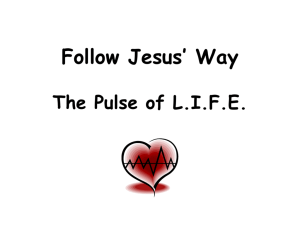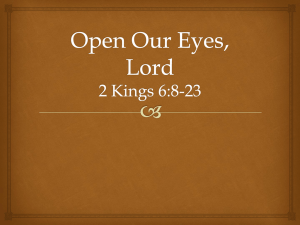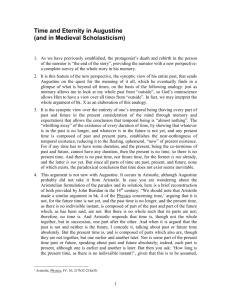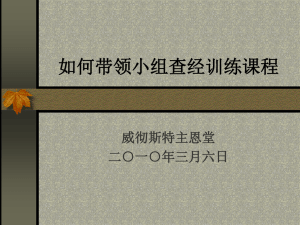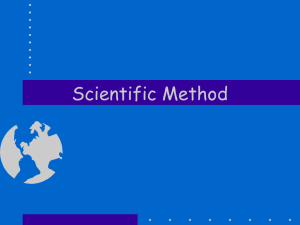Aristotle and Augustine - Physics at Oregon State University
advertisement
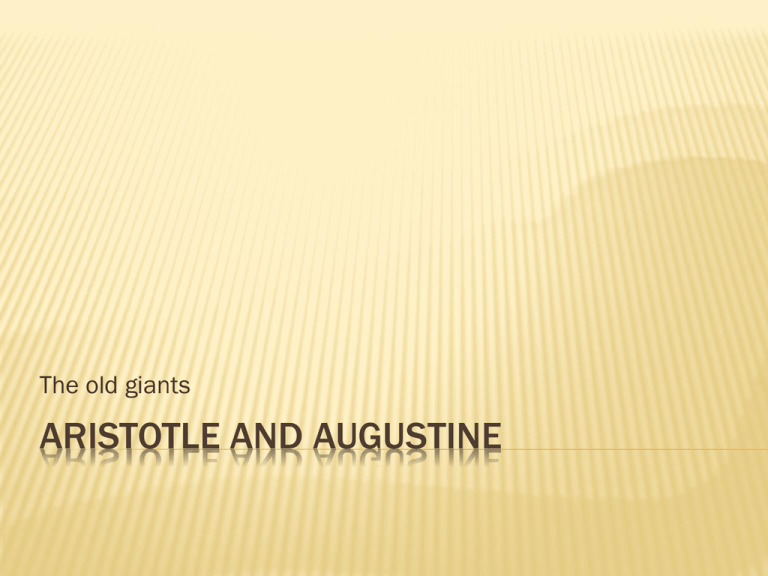
The old giants ARISTOTLE AND AUGUSTINE WHY STUDY ARISTOTLE? He was very important to the medieval church. He is “the father of science.” He regarded theology as a branch of physics! He is a very bad role model for doing physics! ARISTOTLE (384 – 323 B.C.E.) Student of Plato Tutor to Alexander the Great Founded an academy that survived after his death. Wrote an estimated 550 books. THREE KINDS OF SCIENCE Productive sciences Practical sciences Theoretical sciences Mathematical Natural Theological – the study of changeless things SOME WORDS Phusis = nature, “Physics” Ta meta ta phusika = that which comes after physics, “Metaphysics” Etelecheia = being-at-work-staying-itself THE FOUR CAUSES OF A MARBLE STATUE Material cause – marble Formal cause – the plan or design Efficient cause – the chisel Final cause – the purpose of the statue PROOF OF THE EXISTENCE OF GOD Everything has a (final) cause, which has a cause, which has a cause, which ………. This chain can’t go back forever. There must be a first final cause. That would be the cause of all things, i.e. God. So theology is the study of first final causes. ST. AUGUSTINE (354 – 430 C.E.) Born in Africa Joined the Manicheans MANICHEANS: A widespread North African sect that rejected reliance on faith in favor of what could be proven by argument Dualism: envision the world as a constant battle between two forces, food and evil, light and darkness ST. AUGUSTINE (354 – 430 C.E.) Born in Africa Moved to Rome in 383 C.E Accepted a job as professor of Rhetoric in Milan in 384 C.E. Converted to Christianity by St. Ambrose Returned to Africa where he was consecrated Bishop of Hippo in 388 C.E. Died in 430 C.E. AUGUSTINE ON BIBLICAL INTERPRETATION There is a unity of truth. The doctrine of the two books – the book of Nature and the book of Scripture “Let the Bible be a book for you so that you may hear it; let the sphere of the world be also a book for you so that you may see it.” Both of the “Books” require careful interpretation; apparent contradictions arise from incorrect interpretations. Interpreting nature is difficult. Interpreting Scripture is even more difficult. LEVELS OF INTERPRETATION Literal level – not naive literalism Tropological level -- the passage provides an edifying moral Allegorical level – the story prefigures later scriptural material Anagogical level – the story illuminates heaven’s divine plan “LITERAL INTERPRETATION” Interpreting a passage in the Bible so that it maintains some connection to the subject it seems to be describing and assigns meaning to the words so that the passage makes sense in connection with other sources of knowledge. PRINCIPLES OF INTERPRETATION The Bible has an ultimate divine authorship. Biblical expressions are accommodated to their audience(doctrine of accommodation). Our explanations of some particularly troublesome passages can be held only provisionally. It’s often easier to prove natural and philosophical propositions than it is to interpret specific Biblical passages. Interpretation of Scripture must be informed by the current state of demonstrable knowledge. WHY WASN’T HE A SCIENTIST? He simply considered theological knowledge more important. Secular knowledge was considered an ancilla (“handmaiden”) that could assist true religion. Credo ut intellegam: “I believe so that I may understand.” Intellego ut credam: “I understand so that I may believe.” So where do we start? Faith increases with understanding. Some things must first be accepted on faith and then refined by reason thus achieving… Recta fides: right faith Recta ratio: right reason Compare with the 1998 encyclical (teaching document) Fides et ratio “Faith and Reason” issued by Pope John Paul II ST. THOMAS AQUINAS 1225 – 1274 C.E. Educated by the Dominicans which he later joined Canonized as a saint in 1323 C.E. “The definitive source of Catholic doctrine” – Pope Leo XIII in 1879 and the Patron of all Catholic educational institutions SCHOLASTICISM Scholastics attempted to show that the Bible (correctly interpreted) and Catholic doctrine agreed with one another. Aquinas was influenced by the work of Aristotle who held an attractive view of human life and morals without reference to God. It became important to distinguish between that which is accessible to reason and that only accessible through God’s revelation. To put it another way – the difference between natural and supernatural God’s influence was not external but worked through the natural order. CREATION “God saw what He had made and behold it was very good.” Our goal (telos) is to be united with God rather than virtue and in wisdom as with Aristotle. But creation is not a one-time act. God imparts His grace at all moments. Nature is infused with God’s grace. Everything has its proper end in God. Nothing can be fully understood without reference to God’s plan. REALISM VS. NOMINALISM Realism – the representations of the world we have in our minds are in some sense actually united with or participating in the objects in the world that they represent. Objects in the real world exist only by participating in what Plato called “forms” or “ideas.” Platonic forms become the ideas of God. NOMINALISM Our ideas are just names we use to categorize things. They have no independent existence. God being omnipotent can change and affect physical things. God’s will becomes inscrutable. God and nature become separate.

